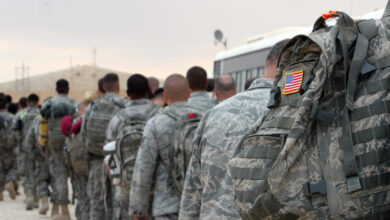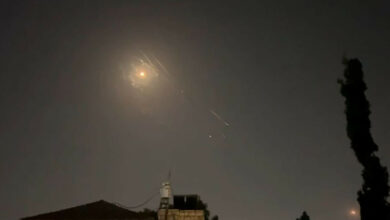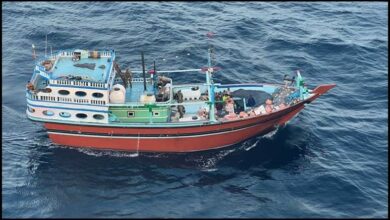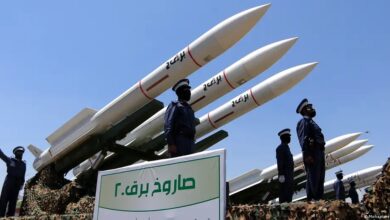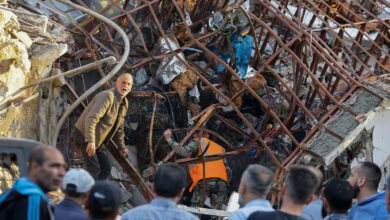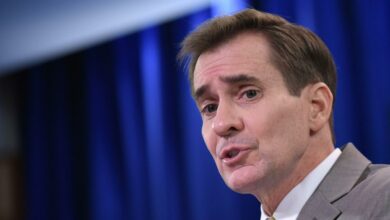Iran’s Kurds avoid full-blown insurgency against Tehran
Kurds fear Iranian assassination campaign after supporting anti-government protests
SULEYMANIYAH/ERBIL, Iraq – On a road in the Kurdistan region of Iraq that leads to the base of Komala, one of the main Kurdish groups in Iran, fighters escorting me stopped and pointed out the spot where Iran allegedly planted bombs on New Year’s Eve. The bombs were placed just a few days after protests erupted in many Iranian cities in late December. The demonstrations lasted throughout the New Year, including in Kurdish cities like Kermanshah. But the bombs were detected before they could explode and hurt Komala leadership.
“This is the second time in the last two years,” Abdullah Mohtadi, leader of the Komala Party of Iranian Kurdistan told The Defense Post over lunch. “This means the Iranian regime is carrying out acts of terrorism both inside and outside of the country. We will keep the right to retaliate in the appropriate time.”
However, he thought it would be wrong for Iranian Kurds to fight Iran militarily right now. “An armed struggle in this situation will become counterproductive and will play in the hands of the Iranian regime,” he added.

History of Iranian assassinations
It is not the first time the Islamic Republic has targeted Kurdish leaders with assassinations. Iranian agents killed Democratic Party of Iranian Kurdistan (PDK-I) leader Abdul Rahman Ghassemlou in 1989 and his successor Sadegh Sharafkandi in 1992.
Two years ago the PDK-I headquarters in the Iraqi Kurdish city of Koye was bombed, killing at least six people. In November last year, the leader of a non-Kurdish Iranian opposition party was also allegedly assassinated in the Netherlands at Tehran’s behest.
A Kurdish safe haven
The leadership of most Iranian Kurdish parties are hosted in the neighboring Kurdistan region of Iraq, a safe haven for the political parties and thousands of Iranian Kurds who fled oppression and the bad economic situation in Iran. Many Kurds from Iran work in various jobs throughout the Iraqi Kurdistan region.
Many of them are also worried about the increasing Iranian influence in Iraq following the fall of Saddam Hussein, and the role that Iran played in undermining the Iraqi Kurds following the September 25 Kurdish independence referendum. Many Kurds in Iran supported this referendum in Iran, and at least 500 were arrested for celebrating the vote’s outcome, Loghman Ahmedi, a Kurdish official from the PDK-I told The Defense Post. Sixty-five people remain in Iranian jails.
Following the anti-government protests Kurdish parties such as Komala, the PDK-I, and the Kurdistan Free Life Party (PJAK) backed pro-democracy demonstrations in Iran. Now they fear retaliation from Tehran.
“The PDKI and Komala are concerned about renewed terrorist attacks against their headquarters,” the two parties said in a joint statement on Friday. “PDKI and Komala therefore call on the international community to take a stance against the Iranian regime’s aggression and international terrorist activities.”
“A firm stance against the regime’s threats of terrorist attacks against Kurdish opposition groups and refugees residing in Iraqi Kurdistan can help dissuade Iran from carrying out such threats,” they said.
Iranian officials including Islamic Revolutionary Guard Corps spokesperson Brigadier General Ramazan Sharif and former IRGC commander Mohsen Rezaei accused the Iraqi Kurds of hosting meetings of Iran’s adversaries to plan the protests, which the Iraqi Kurds vehemently denied.
A Kurdish armed force
Most Iranian Kurdish parties have thousands of Peshmerga forces that are still carrying out attacks against Iranian troops. Some participated in the war against Islamic State in Iraq after August 2014. However, the Iranian government has managed to suppress all Kurdish parties, which largely lack international support.
In October, Iranian Kurds fought against Iraqi troops and protected Erbil, the capital of the Kurdistan region of Iraq, during brief clashes between the Iraqi Kurds and Iraqi forces over control of disputed territories.
On January 11, the Zagros Eagles, an armed Kurdish group affiliated with the PDK-I, carried out an attack on an IRGC military base in the Kurdish city of Piranshah in response to the IRGC’s kidnapping of three civilians in the region following the December protests.
Iranian government media accused Kurdish groups of staging attacks to heighten anti-government sentiment during the demonstrations that are now mostly suppressed or died out.
“An anti-revolutionary terrorist team which had entered Iran to launch armed attacks in false flag operations to heighten anti-government sentiments was disbanded [in Piranshahr],” an Iranian official was quoted as saying by the pro-IRGC Fars News Agency on January 4.

Second-class citizens
Frustration over Iranian governance drove many Kurds to join Iranian Kurdish armed groups or to participate in recent protests in Kurdish-populated cities such as Sanandaj, Kermanshah, Urmiye, Ilam, and the smaller demonstrations in Bokan and Mahabad.
Kurds make up 12-15 percent of the population in Iran and are mainly Sunni. Many feel discriminated against on the basis of their religion and ethnicity in the mostly Persian and Shia country. Kurdish political parties in Iran are banned and their members could face arrest or even execution.
A 46-year-old Iranian Kurdish woman who had just returned to Erbil from Iran said Kurds in Iran are fed up with the situation. “We as Kurds are second-class citizens, people have no opportunities to find jobs,” she told The Defense Post, adding that this was one reason she sought work in Iraqi Kurdistan.
“Shia have jobs, but in Iran no Kurds can become a president or leader, all of them are Persians, or Turks, they cannot be Sunni Kurds,” said the woman, who asked not to be identified citing the dangers of speaking to the media.
But she added that it might be more risky for Kurds to join protests in Iran. Unlike other Iranian cities where police are in charge, in Kurdish cities the military and IRGC dominate security.
“For the Iranian people, either the government or the protesters, both have a common idea that Kurdistan should be part of Iran. Even under the Shah time, we had the same problem. The Kurds should not sacrifice themselves for something without results, we have no hope for the future,” she added.
On Saturday, activists said 24-year-old Saro Qahraman, who was arrested 11 days earlier during anti-government protests in the Kurdish town of Sanandaj, was tortured to death.
“The Kurds have even less jobs and are discriminated in terms of investment and [government financial assistance]. They are the number one in being executed and unemployed. That’s why you see 100,000 kolbars [cross-border smugglers], which even include quite a number of university graduates,” Komala leader Mohtadi said. “And the Iranian government has given a carte blanche to shoot those people.”

Devastating earthquakes in Iran
According to Mohtadi, another motivation for people to rise up against the Iranian government was the deadly November earthquakes and the lack of government help for the victims. Most of the 400 deaths were reported in the Kurdish province of Kermanshah. Despite the devastation, the Iranian government did not accept any foreign aid.
“The movement did not start in Kermanshah, but it became politicized in Kermanshah,” Mohtadi said.
“The economic suffering for the people of Kermanshah is very difficult,” he added. “The government was also very indifferent, ineffective, and corrupt [after the earthquake]. This made a huge dissatisfaction among the people of Kermanshah,” he added.
Hope and change from Trump?
Iranian Kurds are also angry over the Obama administration’s nuclear deal with Tehran. Some are now inspired by the new president Donald Trump’s promise of changing U.S. policy towards Iran and increasing economic sanctions.
“Under Obama, there was no change, and no hope. Now people feel a sparkle of hope,” said the woman who had just returned from Iran. “They hope he is going to make a change in the world.”
According to Mohtadi, the nuclear deal saved the Iranian regime. “The Obama administration had a theory: they thought if you make deals with Iran and say nothing about the atrocities, then it will strengthen the so-called reformists in Iran and will abide by international law, and stop it’s aggressive foreign policy,” he said.
“Instead, it was the opposite. Iran was emboldened, and increased its adventurist policy in Iraq, Syria, Lebanon, and in Yemen against Saudi Arabia and also against Israel, so the opposite has happened.”
He said Iran spent billions of dollars arming Hezbollah with missiles, helping Syrian President Bashar al-Assad kill his own people, supplying the Houthi rebels in Yemen with ballistic missiles, and training terrorists all over the region while Iranians suffer poverty and unemployment.
“The people protested against corruption, discrimination, injustice, economic suffering, as well as the regime,” he added.
According to the PDK-I official Ahmedi, the only solution is regime change, but he still doubts that Trump will make real changes apart from more sanctions.
“The Trump administration seems to understand that Iran poses a real threat to regional and world security and stability. However, we have not seen any real policy action that can bring about change in Iran. The only way to curb Iran’s destructive role in the region is to pursue a policy of regime change,” he concluded.
However, Mohtadi said it’s up to Iranians ‘to take back their country.’
“The change must come from within Iran, but at the same time international support could be very encouraging for the Iranian people,” he said.
Iran’s Supreme Leader Ayatollah Seyed Ali Khamenei recently warned Trump for actions against Iran after the U.S. administration expressed support for the protesters.
“U.S. officials should know that, firstly, they have missed their target: and if they target Iran again, they will fail. Secondly, they have inflicted damage upon Iran in recent days, and they should know this won’t be left without a response,” Khamenei said on Twitter.
“The U.S. President says the Iranian establishment is terrified by their power. Well, if we were so terrified by you, how did we kick you out of Iran in late 70s and send you packing, out of the entire region, in the 2010s?” he added.



